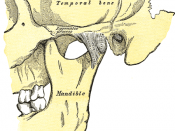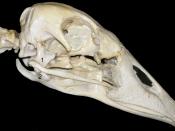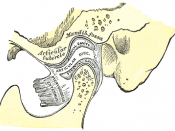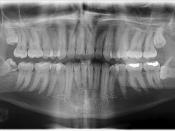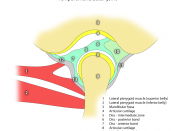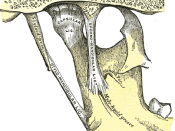It is known as the temporomandibular joint. Located in front of your ears where your jaw meets your face, temporomandibular joint (TMJ) dysfunction can pose for years as one of several other conditions. It is often refereed to as "phantom pain"ÃÂ because TMJ dysfunction can create everything from migraine level headaches to loss of hearing, blurred vision, depression, backaches, and often excruciating facial pain. In some cases, years of pain and frustration go by as the victim proceeds from one doctor to another. Thousands of dollars are spent, as they continue searching for the true cause of possibly the most mysterious and difficult to diagnose condition around.
Sometimes known as "crooked jaws,"ÃÂ temporomandibular joint dysfunction, or TMD in some circles, can best be described as joint stress due to an uneven bite. The symptoms are varied and often illogical. Some people endure multiple root canals and many related surgical procedures before the source of pain in their throbbing teeth is pinpointed.
These sufferers are often told, "it is all in your head,"ÃÂ adding emotional pain which compounds the physical symptoms. Approximately eighty percent of these people are women.
TMD has been an unclaimed stepchild of both dentistry and medicine for the past one hundred years; making it difficult for sufferers to obtain coverage for treatment under any insurance policy. Only in the last 15 to 20 years has much success been obtained in treating this age-old problem. It is actually mentioned in the bible when describing a time of great distress, "There will be weeping and gnashing of teeth."ÃÂ Grinding the teeth, mostly during sleep, and daytime clenching is the main cause for TMD.
Another common culprit is a blow to the head and/or face. Remember Burt Reynolds' widely rumored bout with Aids? He actually had TMD after receiving a blow to the jaw while performing his own movie stunt. It is important to note that mental stress and structural deformities can also cause TMD. In recent years, the link between jaw-joint dysfunction and a long list of other common head and body ailments has been firmly established. These may include recent dental work, extraction of teeth or missing back teeth, birth trauma due to delivery complications, and traction involving the head, jaws, and neck. While the findings show the majority of the country's 20 million chronic sufferers are middle-aged white women, TMD knows no boundaries.
Today's computer age has caused a whole new menu of stressors for our structure. Sitting for hours upon hours, day after day, week after week, and month after month, etc., is bound to cause shortening of the iliopsoas, pectoralis and anterior neck flexors. Straining at computer screens, ever leaning forward, places our temporomandibular joint in front of its natural position. One of the first indications of an impending TM problem is a feeling of "Head Heaviness."ÃÂ It is a very distinct feeling of tiredness in the neck which most people describe by saying, "My head just feels too heavy."ÃÂ Temporomandibular disorders are a significant problem which also affects musicians. The symptoms are activated and heightened when practicing or performing. TMD symptoms appear to be most significant in trombone, trumpet, tuba, violin and viola musicians. Brass instruments place constant pressure on the TM joint, as the jaw is held forward and the instrument presses backward. Violinists have chronic jaw and neck problems from constant abnormal head posture as they hold their instrument between their jaw and their shoulder. Vocalists are also affected by TMD. They frequently injure, and often disarticulate, the TM joints while excessively exercising the mouth in an attempt to increase the volume for a more perfect sound. Often, the advice will be to quit playing musical instruments or singing if the jaw discomfort is great.
Then there is the difficult to diagnose TMD which originates as a soft tissue injury. This type of TMD often goes untreated and usually worsens with time. It is important to note the out-come of this type of dysfunction is often slow and insidious. A lot of people, including medical professionals, continue to think of it as a neurotic, mid-life-crisis-woman-disease. However, those who have experienced this pain know its reality is undeniable. TM dysfunctions may vary from a small, painless click in the jaw to the need for surgery. With time, additional systems and organs often become involved. Eventually the symptoms seem to have no relationship at all to the joint where it started.
In many cases, the pain may come and go. Treatments may be effective for only a short time. Misdiagnosed sufferers are often sent to a psychiatrist. Some are subjected to surgery to fracture the jaw in order to take pressure off of the TM joint. Often the relief is ineffective, or effective for only a short while, manifesting as pain in a different location, such as the back. Due to a lack of knowledge, many people who should receive treatment for TMD end up on a psychiatrist's couch instead. Both medical and dental specialists send them there. It is because many professionals are unfamiliar with the symptoms of TMD, that their patients are misdiagnosed.
And what are those symptoms? Denise Trump, an illustrator and writer almost committed suicide before her "unendurable pain"ÃÂ was diagnosed and corrected. Her symptoms were headaches, depression, fatigue, noisy chewing and sharp pain when she yawned or bit into a hard object. She finally discovered the surface of her upper jaw and her lower jaw didn't meet properly when she closed her mouth. As a result, her jaw moved slightly out of line to make them fit. This caused a constant strain on the TM joint and all the muscles surrounding it. Like misaligned tires on a car, they slowly but surely threw everything, down to her toes, out of balance.
Once diagnosed, Ms. Trump's alignment problem was corrected with massage therapy and a simple bite plate or splint. The combination of these two therapies enabled the masticatory muscles to relax and her jaw to move back to its natural position. Her headaches, fatigue and pain were immediately remedied after one massage therapy treatment. By wearing the splint, which fits over the teeth like a football mouthpiece, her bite returned to normal and the pain subsided. This literally saved her life! Even though the Temporomandibular joint is the most complicated joint in the body, as well as the only joint that is hinged at two points, most TMD cases are simple. Fixing a malocclusion, or bad bite, usually requires nothing more than massage therapy treatments and a basic orthopedic adjustment with a bite plate. However, it must be with certainty that the patient is diagnosed with TM dysfunction; this can be quite a chore.
As previously stated, "The Great Imposter,"ÃÂ TMD has a way of mimicking numerous other nerve-related ailments. Some sufferers have bounced back and forth between, gynecologists, internists, neurologists and chiropractors before they found relief. Upon Dentist or Chiropractor's recognition of TMD, a patient is often referred to an L.M.T. who specializes in relieving musculoskeletal, Temporomandibular joint induced, myofascial pain.
One such person found that her teeth hurt because of a blocked nerve at the tip or her lung. Another was told by her counselor that she was not coping well, which was "normal"ÃÂ for someone of her gender and (middle) age and hardly severe enough to warrant physical attention. Medication and a psychiatrist were the antiquated prescription these desperate victims took home. Modern practice has taken a different route.
Lasting results require diet, behavioral changes.
The first step in treatment is a thorough patient history and examination of the offending joint. Does she wake up with a stiff jaw or pain behind the eyes? Does she have problems chewing? Do her lips come together? If a bite splint doesn't work, a physician may prescribe medications such as anti-inflammatorys. He might try special diagnostic studies, such as tooth impressions, X-rays, CAT scans or special TMJ films to reveal abnormalities of the jaw line.
Some with this malady testify that a simple brace"ÃÂor orthopedic repositioning appliance, in dental terminology, solved as much as seventy five percent of their headaches the first night. The brace not only repositions the jaw, it also allows the facial and chewing muscles to work with, the neck and shoulders to relax and tension to disappear.
But there's more to it than a plastic crutch, expert's say.
Lasting results, more of ten than not, require behavior modification, diet and other stress reduction techniques.
Virginia's Dr. Brendan Stack says that repositioning the jaw will reduce pain and spasm. But, he adds, if behavior such as a bad posture or tooth grinding are the root cause, then relief will only be temporary.
Therapy without drugs can also be part of the answer. Pain areas, such as irritated nerves or inflamed muscles can be treated with ice packs and local anesthetics. Massage therapy to the muscles of the head, neck and jaw by a licensed massage therapist trained in the specifics of TMJ massage has proven very effective in almost all cases. Exercises to strengthen involved muscles also help.
Even with careful diagnosis and treatment, not everyone ends up with a successful treatment. Eight in Ten sufferers experience significant diminished pain or even total eradication. One out of every ten may require surgery. The lone one left, may not find their miracle; some people, are unable to find what's causing their pain.
TMJ Symptoms: If you think that TMJ dysfunction might lie at the root of your problems, here are some questions you might ask yourself: Do you have a grating clicking cracking or popping sound in your jaw joint when you chew? Do you feel stiffness, pressure or blockage in your ears, or excessive wax production? Do you ever have a ringing, roaring hissing or buzzing sound in your ears? Do you ever fell dizzy or faint? Is your jaw painful or locked when you get up in the morning? Are your ever nauseous for no apparent reason? Do you fatigue easily or consider yourself chronically fatigued: Are there imprints of your teeth on the sides of your tongue? Is it possible to swallow quickly five times in a row with the last swallow being as easy as the first"ÃÂ Does your tongue go between your front teeth when you swallow' Do your fingers sometimes go numb? Do your have pain or soreness in your jaw joints, teeth, side of the neck, back of the head, forehead, behind the eyes, temples, tongue or chewing muscles? Is it hard to move your jaw from side to side or forward and backward? Do you have difficulty chewing your food? Do you have any missing back teeth? Do you clench your teeth during the day? Do you grind your teeth at night? Do you clench your teeth during the day? Have your ever had a whip-lash injury"ÃÂ Have you ever experienced a blow to the chin, face or head? Does chewing gum start your symptoms? Is it painful when you press on your jaw joints or the cheek just6 below them? Have you reached the point where drugs no longer reliever your symptoms? Does your jaw deviate to the right or left when you open wide? (Look in the Mirror.) Are you unable to insert your first three fingers vertically in your mouth when it is opened wide? If you answered "yes"ÃÂ to a substantial number of these questions, it might be time for a thorough dental examination. If your dentist is unfamiliar with TMD or thinks it might be "all in your head,"ÃÂ consider seeking a second opinion
